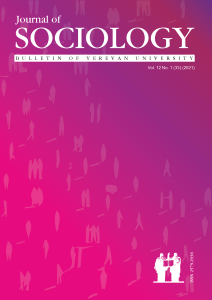Armenian Digital Communications in Karabakh War of 2020: Critical Discourse Analysis
DOI:
https://doi.org/10.46991/BYSU:F/2021.12.1.032Keywords:
Nagorno-Karabakh conflict, war framing, social media, digital communication, critical discourse analysesAbstract
The role of media and communication in modern military conflicts is becoming more and more relevant. In this regard, the Karabakh war of 2020 was significant։ it was the first large-scale war in the modern history of Armenia, which took place under the conditions and with the use of digital communications. The article provides a critical discourse analysis of war framing in digital communications. The analysis revealed the techniques and mechanisms of framing, the underlying stereotypes, myths and ideologies, as well as the role of social networks in digital communications that accompanied military operations.
References
Bernays, E. (1923). Crystallising public opinion. New York, NY: IG Publishing
Herman, E. S. & Chomsky N. (2002). Manufacturing consent: The political economy of mass media. New York, NY: Pantheon Book
Lasswell, H. D. (1927). The theory of political propaganda. American Political Science Review, 21(3), 30, 1927, 627–631. Doi: https://doi.org/10.2307/1945515
Browne, H. (2004). The War Racket_The Lies, Myths, and Propaganda That Feed the American War Machine. Nelson Current, 2004, 9-10
Bodriiar, J. (2016). Voiny v zalive ne bylo. RIPOL klassik, Moscow
Welch, D. & Fox, J. (2012). Justifying War Propaganda, Politics and the Modern Age. Palgrave Macmillan UK, 16. Doi: https://doi.org/10.1057/9780230393295
Libicki, M. C. (2007). Conquest in Cyberspace - National Security and Information Warfare. Cambridge University Press, 34. Doi: https://doi.org/10.7249/CB407
Guenther, L., Ruhrmann, G., Bischoff, J., Penzel, T. & Weber, A. (2020). Strategic Framing and Social Media Engagement: Analyzing Memes Posted by the German Identitarian Movement on Facebook. Social Media + Society, 6(1), 1-13. Doi: https://doi.org/10.1177/2056305119898777
Nelson, T., Oxley, Z. & Clawson, R. (1997). Toward a Psychology of Framing Effects, Political Behavior, 19: 3, 221–46. Doi: https://doi.org/10.1023/A:1024834831093
Atanesyan, A. (2020). Media Framing on Armed Conflicts: Limits of Peace Journalism on the Nagorno-Karabakh Conflict, Journal of Intervention and Statebuilding, 2020. DOI: https://doi.org/10.1080/17502977.2020.1780018
Norris, P., Kern, M. & Just, M. (2003). Framing Terrorism. The News Media, the Government and the Public. Routledge, 8. Doi: https://doi.org/10.4324/9780203484845
Evans, M. (2010). Framing international conflicts: Media coverage of fighting in the Middle East, International Journal of Media and Cultural Politics, 6 (2), 209–233. Doi: https://doi.org/10.1386/mcp.6.2.209_1
Makhortykh, M. & Sydorova, M. (2017). Social media and visual framing of the conflict in Eastern Ukraine, Media, War and Conflict, 10(3), 359-381. Doi: https://doi.org/10.1177/1750635217702539
Iskandaryan, A. (2020). The second Karabakh war, or the first postpost-soviet war, Caucasus Institute, Vienna. Retrived from: https://www.institutfuersicherheit.at/wp-content/uploads/2020/12/ISP-Working-Paper-Alexander-ISKANDARYAN-The-Second-Karabakh-War-or-the-First-Post-Post-Soviet-War.pdf
Atanesyan, A (2013). Hamacancy vorpes LGH azgayin anvtangutyan teghekatvakan pashtpanutyan hartak. 21-rd DAR, No 6 (52), Yerevan, 56
Nazaryan, H. (2017). Adrbejani teghekatvakan qaghaqakanutyuny aprilyan qarorya paterazmum. Banber Yerevani hamalsarani. Mijazgayin haraberutyunner. Qaghaqagitutyun No 1 (22), 54-63
Foucault, M. (1980). Power/knowledge: Selected interviews and other writings. New York: Pantheon
Fairclough, N. (1993). Critical discourse analyses and the marketization of public discourse: the universities, 134-135. DOI: https://doi.org/10.1177/0957926593004002002
Wodak, P.R. & Meyer M. (2001). Methods of Critical Discourse Analysis. SAGE Publications, London, 11-37. Doi: https://doi.org/10.4135/9780857028020
Van Dijk, T. A. (1995). The Aims of Critical Discourse Analysis’, Japanese Discourse, 1. 17-27. Doi: https://doi.org/10.1177/0957926595006001001
Van Dijk, T. A. (2000). Ideology and discourse. A Multidisciplinary Introduction, SAGE Publications Ltd, London, 44
Van Dijk, T. A. (1988). News As Discourse, Lawrence Erlbaum Associates, Inc, 37-38
Androutsopoulos, J. (2008). Potentials and limitations of discourse-centred online ethnography. Language@Internet 5(8)
Herring, S. C. (2004). Computer-Mediated Discourse Analysis An Approach to Researching Online Behavior, Cambridge University Press, 2. Doi: https://doi.org/10.1017/CBO9780511805080.016
Eisenlauer, V. A (2015). Critical Hypertext Analysis of Social Media - The True Colors of Facebook, Bloomsbury Academic, 96
Moberg, M. (2018). Mediatization and the technologization of discourse: Exploring official discourse on the Internet and information and communications technology within the Evangelical Lutheran Church of Finland. New media & society, Vol. 20(2), 515–531. Doi: https://doi.org/10.1177/1461444816663701
Luhmann, N. (1982). Trust and Power, John Wiley & Sons Inc., 20
Bruce, M.D. (2014). Framing Arab Spring Conflict: A Visual Analysis of Coverage on Five Transnational Arab News Channels, Journal of Middle East Media, Vol 10, 4. Doi: https://doi.org/10.12816/0023470
Downloads
Published
How to Cite
Issue
Section
License
Copyright (c) 2021 Anahit Hakobyan

This work is licensed under a Creative Commons Attribution-NonCommercial 4.0 International License.








